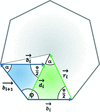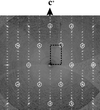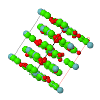issue contents
April 2013 issue

Cover illustration: Reduction of volumes of the voids in the crystal structures of DL-alanine and L-alanine on application of 6 GPa of pressure. Yellow voids are shown within the ball-and-stick structure models. The molecules as well as the topologies and symmetries of their packings are preserved over the whole pressure range of 0-6 GPa. See Fig. 4 in Tumanov & Boldyreva [(2012), Acta Cryst. B68, 412-423].
lead articles
Free 

The use of aspherical atomic scattering factors in the structure refinements of organic molecular crystals is reviewed. Aspherical atomic scattering factors within the invariom database are presented as an alternative to standard atomic scattering factors in structure refinements.
research papers
The reaction of carbon dioxide on a BaTiO3 (001) reconstructed surface is analyzed with atomic resolution scanning tunneling microscopy.
Magnesium–cobalt cordierites of hexagonal structure were synthesized by annealing glasses obtained from colloidal gel precursors and were investigated by means of X-ray powder diffraction and scanning electron microscopy. The formation of solid solutions with hexagonal structure (α-cordierite) in two concurrent crystallization paths, immediate crystallization or via phase transformation of intermediate μ-cordierite, was observed. The parameters of the crystalline structure and microstructure were extracted from X-ray diffraction patterns as mutually correlated in dependence on cobalt content.
The superspace formalism has been successfully applied to obtain a (3 + 1)-dimensional model unifying the description of the monophosphate tungsten bronzes with pentagonal tunnel homologous series.
Download citation


Download citation


Temperature-dependent crystal structures reveal a variation of tilts of the octahedral (Ti,Fe)O6 groups as the mechanism for the anisotropy of the thermal expansions of the title compounds. The local charge compensation is proposed as the driving force for the observed Ti/Fe chemical order.
B-IncStrDB reference: 6872EpvgNl
New bond-valence parameters r0 and b have been re-determined for TeIV—O, TeVI—O and TeIV—Cl.
Open  access
access
 access
accessThe importance and utility of proper crystal-chemical and geometrical reasoning in structural studies is demonstrated through the consideration of layered single and double hydroxides. New yet fundamental information is provided and it is evident that the crystal chemistry of the double hydroxide phases is much more straightforward than is apparent from the literature.
This work proposes the concept of a single chemistry which unifies the apparently contradictory bonding descriptions and structural models which are applied to molecular and extended solids, and thereby provides a more rational understanding of these materials.
A data-mining study of non-corrin cobalt(II) sites in proteins has allowed the computation of new target distances which are compared with EXAFS and CSD data; the apparent dependence of metal–donor lengths on structure resolution, previously also reported for other metals, is explored.
Download citation


Download citation


Four new structures belonging to the phosphoric triamide family have been studied, and their N—H⋯O hydrogen bonding is compared with that in 118 analogous structures from the Cambridge Structural Database.
Download citation


Download citation


The crystal structure of n-butanol at 110 K was solved from X-ray powder diffraction. The microstructural analysis performed in the crystal was related to the description of the microstructure in the glacial state.
Download citation


Download citation


Dynamic model densities of the invariom model and the independent atom model from high-order refinement are shown to produce reliable MEM density maps when employed as a prior density map. The performance of these priors is considerably better than of the independent atom model as prior.
Download citation


Download citation


The highly hydrated α-cyclodextrin/1-undecanol host–guest complex was studied by single-crystal neutron diffraction. The supramolecular multichannel assembly based on cyclodextrin dimers which act as building blocks, each fully enclosing the lipid guest, is stabilized by an exceptionally rich water-mediated hydrogen-bond network.


 journal menu
journal menu






























